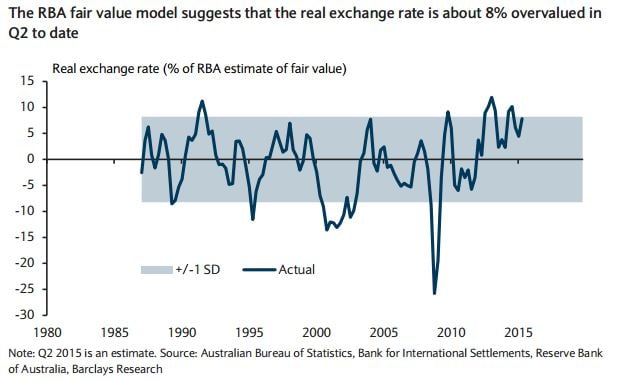Sell the Australian Dollar Recommend Barclays Forecasters
A weekly FX note from Barclays has confirmed the bank’s strategic view that selling the Australian dollar offers speculators the chance to profit.
The RBA’s board minutes released on Tuesday were dovish as they confirm the RBA’s discomfort with the strength of the AUD.
The falls come as a leading institutional analyst confirms to clients they are forecasting more declines ahead and recommend a sell on AUD-USD with a relevant stop-loss and target level recommendation.
Currency strategists at Barclays see three factors behind AUD weakness for the remainder of 2015 and into 2016:
- weak non-mining activity; the previously resilient non-mining sector has begun to show signs of weakness, removing one of the hopeful signs that supported the AUD last year.
- deteriorating risk conditions; Australia’s economy and assets have worsened the outlook for Australia’s risk-adjusted relative returns, especially in an environment of impending US rate rises.
- worsening overvaluation as a result of poor trading partner growth and continued declines in commodity prices. A 10% overvaluation in the currency is suggested due to weakening terms of trade and faces still-slowing Chinese demand for Australia’s commodity exports.
For reference, at the time of writing the Australian to US dollar exchange rate (AUDUSD) is at 0.7737 with trade likely to flatten ahead of the mid-week FOMC event.
The pound to Aus dollar exchange rate (GBPAUD) is at 2.0161 and the euro to Australian dollar rate (EURAUD) is at 1.4600.
Note that currency quotes in this piece refer to the inter-bank market, your bank will then subject a spread when offering you their retail rate for international payments. However, an independent currency provider will seek to get closer to the market, this can result in up to 5% more currency can be achieved in some instances.
Aussie Dollar is Overvalued
If the Reserve Bank of Australia believes the currency to be overvalued it may well pursue policies to push the exchange rate lower.
Just look at how effective recent action taken by the Reserve Bank of New Zealand has been on the expensive NZD, the currency has plummeted and is the worst performer in G10 over the past two months.
It is believed that the RBA are seeing the Australian dollar as overvalued to the tune of 8%:
The AUD remains overvalued in the context of low commodity prices and continuing weakness in Chinese demand and the RBA continue to note that further currency depreciation “seems both likely and necessary, particularly given the significant declines in key commodity prices”.
China A Source of Weakness
Much of the AUD outlook depends on the path of commodity prices. “As China’s growth moderates further (note our GDP forecast is 6.8% for 2015) the outlook for key commodity imports is likely to worsen,” says Barclays’ Hamish Pepper in note on the matter.
From a medium term perspective it is argued that the next five years will bring huge changes in China’s commodity demand.
“The shift will likely not bode well for Australia especially as China’s influence in global industrial metals markets greatly diminishes, although its likely impact is tempered by the fact that Australia is a low cost/high quality producer of iron ore, whereas China is a high cost/low quality producer,” says Pepper.
There is also a degree of spare capacity in the economy that needs to be overcome. Spare capacity simply suggests that labour and capital are not operating at full potential.
“Australia’s sluggish economic growth indicates a degree of spare capacity in the economy and is likely to weigh on the AUD through relatively poor returns to capital,” notes Pepper.
Indeed, the RBA confirmed in their June statement that “the economy is likely to be operating with a degree of spare capacity for some time yet.”
Barclays make the argument that it is returns to capital that ultimately drive currencies.
“Exchange rates are the prices that equilibrate returns to capital across economies, shifting capital from economies with an excess (hence lower returns to capital), such as Australia, to economies with a shortage (providing higher returns),” suggests Pepper.
As such, Barclays recommended a short AUDUSD spot position in anticipation of future losses:
“We recommend initiating a short AUDUSD spot position targeting 0.70 with a stop-loss at 0.8180, above recent highs and ensuring a 2:1 reward-to-risk ratio.” A spot exchange rate reference of 0.7779 when making the call.











